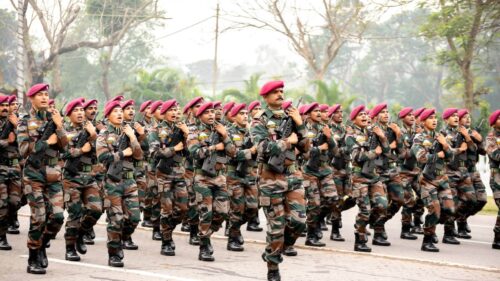The concept of red lines shot into prominence in the Indian subcontinent in 2002, in the aftermath of the terrorist attack on the Indian Parliament on December 13, 2001. In a conversation with two Italian physicists that year, General Khalid Kidwai, the head of Pakistan’s Strategic Forces Division, identified four red lines that could trigger Pakistan to use nuclear weapons:
- India captures a large part of Pakistan’s territory (spatial threshold).
- India destroys a large part of Pakistan’s armed forces (military threshold).
- India strangles Pakistan economically (economic threshold).
- India destabilizes Pakistan internally (political threshold).
In other words, for every possible Indian action against Pakistan, Islamabad has declared a red line, and it places no restriction on initiating a nuclear strike. Though these thresholds remain vague and rest entirely on Pakistan’s perception, cultivated air of irrationality and nuclear saber-rattling keeps the deterrent threat alive.
Pakistani aggression operates behind a nuclear shield
India has no ambitions to expand its territory. It has always been a status quo power that only seeks to regain territory it legally inherited from the British colonial government at independence. Pakistan, by contrast, used intrigue and deception, in collaboration with the British, to seize Gilgit-Baltistan. On November 2, 1947, Major William Brown, the British commander of the Gilgit Scouts, raised the Pakistani flag in Gilgit and declared its accession to Pakistan. The British government did not intervene and instead awarded Brown the Order of the British Empire (OBE) in 1948. Pakistan posthumously awarded him the Sitara-e-Imtiaz, its third-highest civilian honor, in 1993.
Pakistan confirmed its revisionist posture by launching the invasion of Kashmir in October 1947, leading to the first India–Pakistan War. The ceasefire line from that war became the mutually agreed Line of Control (LoC), across which Pakistan has shelled civilian areas since India conducted airstrikes on nine terrorist camps on 7 May in retaliation for the Pahalgam terror attack.
After Kidwai declared Pakistan’s red lines in 2002, then-Pakistani President Pervez Musharraf repeated them later that year. India, for its part, has adhered to its “No First Use” nuclear doctrine and has not crossed any of Pakistan’s stated red lines. This may have lulled Pakistan into believing that it had neutralized its conventional military inferiority. Pakistan relied instead on its low-cost strategy of cross-border terrorism to bleed India. It first developed this approach by training and deploying mujahideen in Afghanistan at the request of the US to push out the Soviet Union. After the Soviet withdrawal, Pakistan redirected these fighters to Kashmir. It assumed that terrorism gave it an inexpensive means to inflict pain on a stronger India.
Pakistan carried out the 26/11 Mumbai terrorist attacks in November 2008. India responded through diplomatic and legal channels, but Pakistan remained emboldened. It then launched the Uri attack in September 2016. India responded with a cross-LoC surgical strike that destroyed launch sites used for infiltration. This was Pakistan’s first major shock.
Less than three years later, Pakistan executed the Pulwama terror attack in February 2019. India responded with an airstrike on a terrorist camp in Balakot, located inside Pakistan.
Six years after Pulwama, and despite its own economic crisis and internal security threats from Afghanistan and Balochistan, Pakistan has now perpetrated the Pahalgam massacre, selecting victims by religion.
To the present day, Pakistan has used terrorism as a substitute for conventional warfare. What it failed to achieve in war, it seeks to gain by destabilizing Kashmir through terrorism. Its ambitions there are the same as its seizure of Gilgit-Baltistan: to acquire territory by means other than open war.
India must become ready to use its own firepower
After Pahalgam, India had no choice but to launch Operation Sindoor, carrying out limited strikes within Pakistani territory to avenge the victims and reassure an outraged public. General Ved Prakash Malik, former Chief of the Indian Army during the 1999 Kargil War, questioned the strategic effect of the operation, however. On his X account, he wrote:
Ceasefire 10 May 2025: We have left it to India’s future history to ask what politico-strategic advantages, if any, were gained after its kinetic and non-kinetic actions post Pakistani horrific terror strike in Pahalgam on 22 April.
Even a layperson would reasonably ask: If India has conducted military operations in response to terrorism since 2016, why does Pakistan continue to cross this line?
The answer lies in strategy. But India has never formally stated its red line against cross-border terrorism or the consequences for violating it. By contrast, Pakistan’s nuclear doctrine permits first use if it perceives that India has crossed one of its thresholds. Pakistan’s readiness to use nuclear weapons first enhances the credibility of its deterrence. That places the burden of escalation on India.
India rules out first use, putting itself at a disadvantage. Pakistan continues to export terrorism despite evidence, UN designations of terrorist groups, diplomatic efforts, and Indian military responses. Terrorism has already claimed too much Indian and foreign blood. If Pakistan can back four red lines with the threat of nuclear first use, why can’t India back its one red line with the same?
India must declare that terrorism is its red line and that crossing it could trigger a nuclear strike of a size and timing of its choosing. Simply removing the No First Use clause from India’s doctrine would change the nuclear equation.
Inflict pain now, then more later
India suffers from confusing deterrence with compellence. Deterrence means stating a red line and threatening to respond if the adversary crosses it. It aims to preserve the status quo. Deterrence alone does not change behavior.
Compellence, by contrast, means causing pain now and demanding a change in behavior lest more pain follow. Nobel laureate Thomas Schelling explains this in his book Arms and Influence.
Pakistan continues to utilize terrorism because India has not made it dread what might come next. The pain must fall primarily on the Pakistani Army, which uses the conflict to justify its power and privileges, even if doing so crosses Pakistan’s military threshold. India calls this strategy option “punitive deterrence,” but what it really means is compellence.
What that intolerable pain should be is a decision for India’s political and military leadership. But until India compels Pakistan to change, terrorism will persist. The next attack is only a matter of time.
The views expressed in this article are the author’s own and do not necessarily reflect Fair Observer’s editorial policy.
Support Fair Observer
We rely on your support for our independence, diversity and quality.
For more than 10 years, Fair Observer has been free, fair and independent. No billionaire owns us, no advertisers control us. We are a reader-supported nonprofit. Unlike many other publications, we keep our content free for readers regardless of where they live or whether they can afford to pay. We have no paywalls and no ads.
In the post-truth era of fake news, echo chambers and filter bubbles, we publish a plurality of perspectives from around the world. Anyone can publish with us, but everyone goes through a rigorous editorial process. So, you get fact-checked, well-reasoned content instead of noise.
We publish 3,000+ voices from 90+ countries. We also conduct education and training programs
on subjects ranging from digital media and journalism to writing and critical thinking. This
doesn’t come cheap. Servers, editors, trainers and web developers cost
money.
Please consider supporting us on a regular basis as a recurring donor or a
sustaining member.
Will you support FO’s journalism?
We rely on your support for our independence, diversity and quality.










Comment
Good Sir,
Sadly, I agree with you entirely. A next attack is only a matter of time. For all its population and military size, India is a babu state, run by petty bureaucrats, lacking grand strategy.